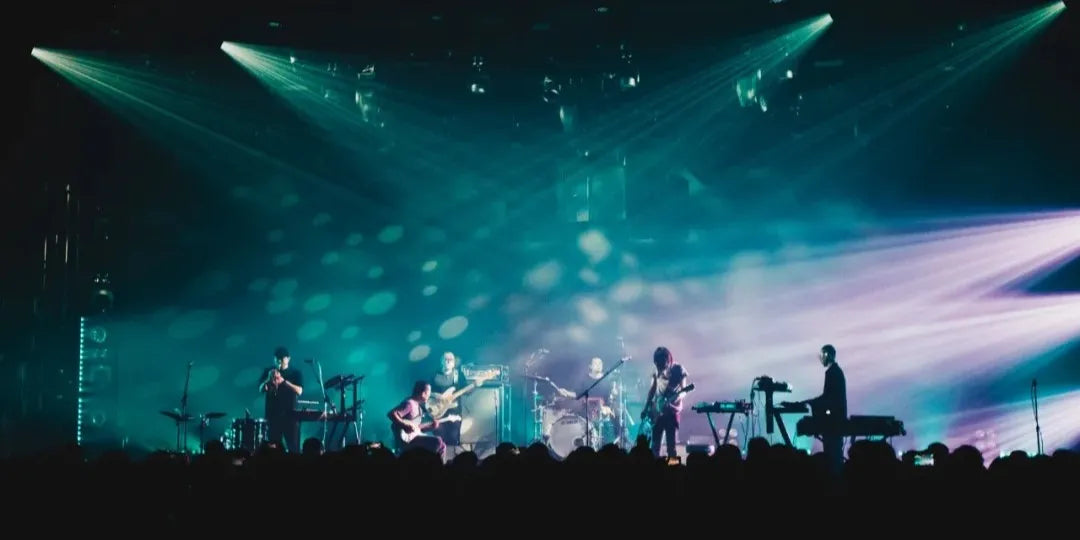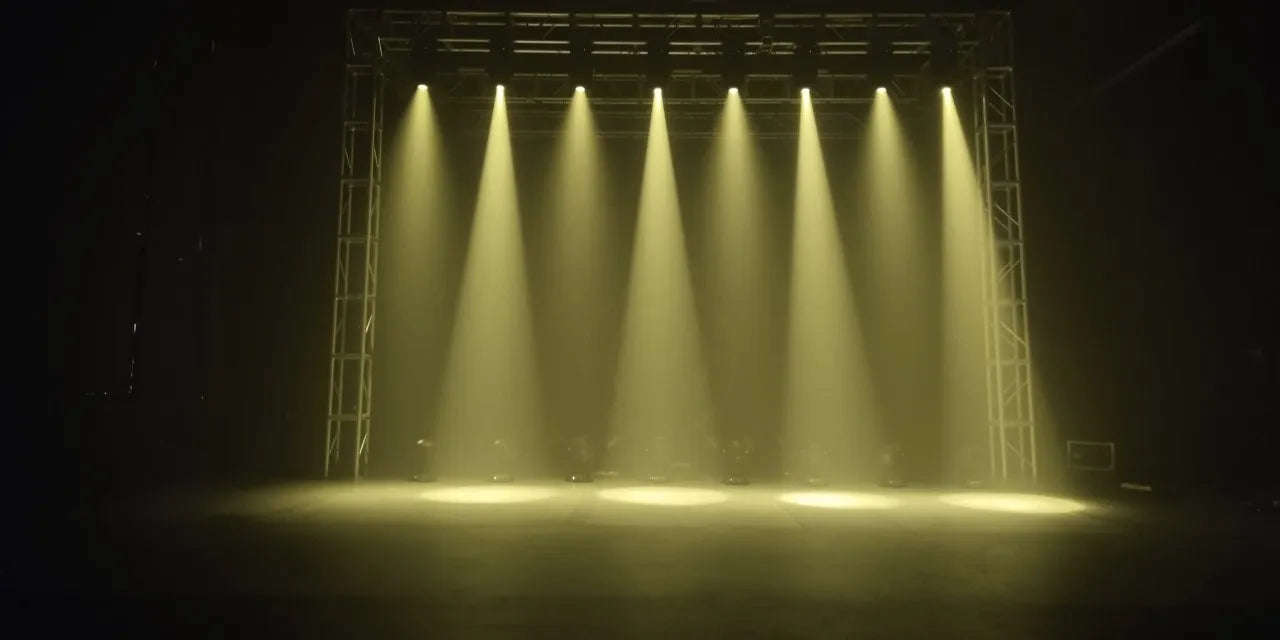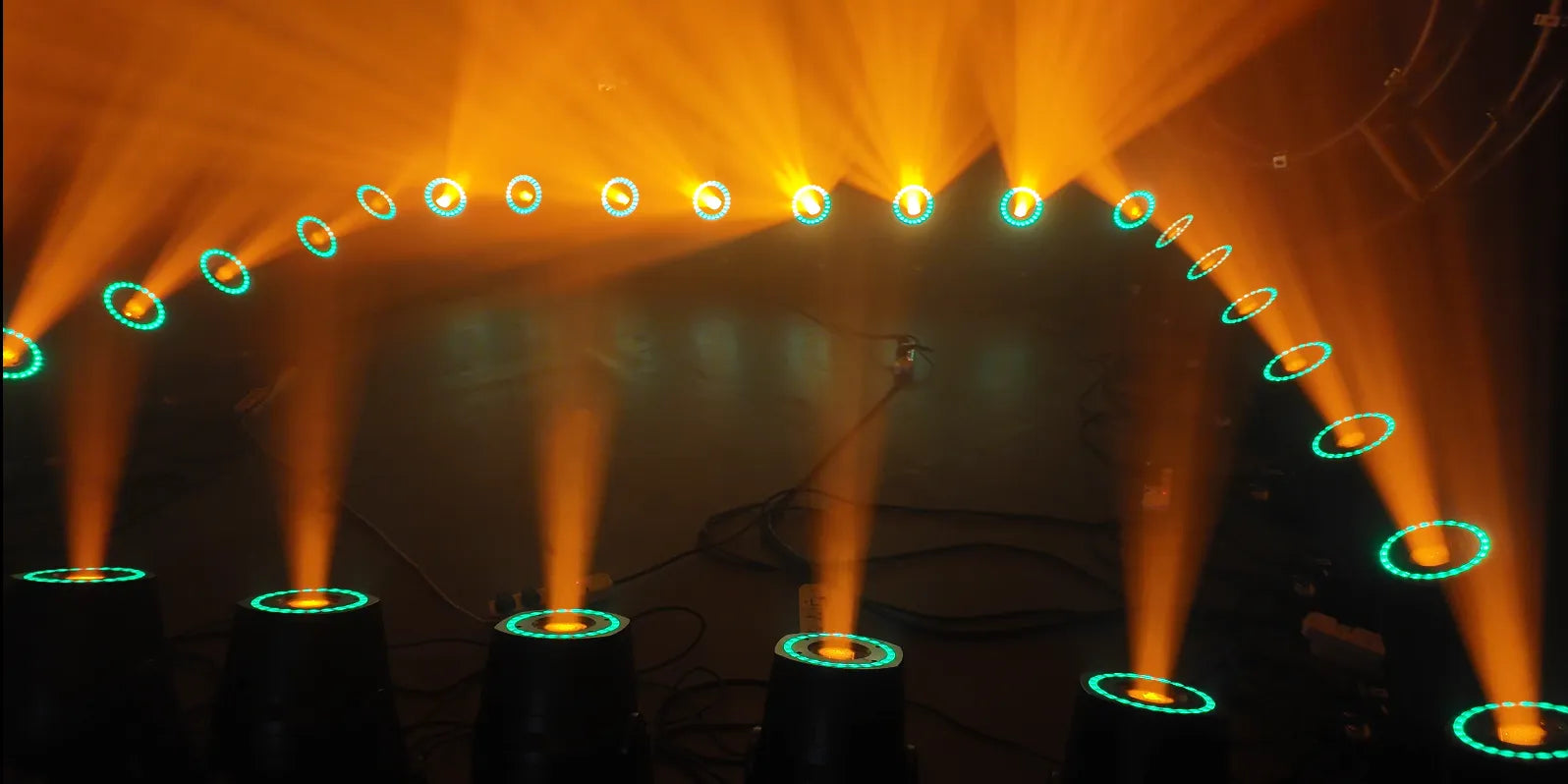Lighting does more than make a stage visible—it sets the tone, guides the audience’s focus, and defines the entire mood of a performance. The same lighting rig that electrifies a concert arena can feel overwhelming in a wedding hall, while a setup designed for a small club would fade into the background on a large stage.
The key to professional results lies in balance: align your lighting design with your venue’s scale and purpose. This guide breaks down fixture types, explains how event size influences lighting choices, and provides practical insight into layouts, safety, and purchasing decisions.

What Is Stage Lighting—and Why Does Size Matter?
Stage lighting covers a diverse range of fixtures—from wash lights that provide smooth, even coverage to beam and spot lights that cut through haze with precision. LED PARs add color depth, pixel bars bring motion, strobes and blinders inject intensity, and hybrid fixtures combine multiple effects into one versatile unit.
These lights can be operated through several control systems: from basic auto programs, sound activation, or wireless remotes for small events, to DMX512, Art-Net, or timecode-based systems for complex, synchronized productions.
Why size matters: your venue’s scale directly affects how much brightness, throw distance, and control precision you need. Too little output leaves large stages looking dull and empty; too much power in a small room feels uncomfortable and distracting. The right balance ensures your lighting enhances the performance—never overwhelms it.
Lighting for Small Events & Venues
(House parties, wedding halls, lounges, small clubs—up to ~150 guests or <200 m²)
Main Characteristics
- Compact & portable: lightweight LED PARs and mini moving heads for quick setup.
- Moderate brightness: delivers ambience and accent effects without overpowering guests.
- Simple control: IR remote, app control, or basic wireless DMX for convenience.
Best Applications
- Weddings (ambient uplights and 2–4 compact movers for the dance floor).
- Private parties & lounges (soft washes combined with light haze for mood).
- Small clubs (fast color changes and motion effects in compact rigs).
💡 For example, the Betopper LM1915R 19x15w Wash Moving Head with Halo Ring featuring a light strip effect, offers rich RGBW color mixing, a zoom function for both wash and beam looks, and a built-in strip effect that adds visual flair—making it perfect for intimate venues where compact fixtures need to deliver both atmosphere and standout effects.
Lighting for Mid-Sized Stages
(200–500 seat theaters, banquet halls, mid-size concerts)
Main Characteristics
- Brightness & coverage: strong washes that eliminate dark spots across the stage.
- Layered effects: washes create a base; beams highlight cues; pixel bars add movement.
- DMX control: enables programmed scenes and smooth transitions between looks.
Best Applications
- Theater & dance (warm washes for dialogue, cool side light, accent beams for cues).
- Corporate events (clear key light for presenters, plus dynamic reveals).
- Banquet weddings (layered washes and beams with haze for depth).
💡 A fixture like the Betopper LM0740 7x40w Wash Moving Head Stage Light featuring high-output 40W LEDs, a motorized zoom for flexible coverage, and smooth color transitions, making it especially effective for theaters and banquet halls where both power and refinement are required.
Lighting for Large Concerts & Arenas
(Indoor arenas, stadium tours, large-scale productions)
Main Characteristics
- Extreme output & throw: high-power beams and hybrid fixtures reach the back rows.
- Advanced effects: prisms, gobos, zoom/focus, strobes, and audience blinders for impact.
- Professional control: multi-universe DMX, Art-Net/sACN, and timecode syncing with video, audio, and special effects.
Best Applications
- Arena concerts (sharp beams and strobes timed with music drops).
- Stadium tours (long-throw beams and bright strobes that translate across large spaces).
- Large productions (layered hybrids with haze to build immersive atmospheres).
💡 For large venues, fixtures like the Betopper LB295 295w Pro Moving Head Beam Light—featuring tight optics, high-intensity 295W output, and prism/gobo effects—cut through haze with dramatic clarity. When paired with the Betopper LF4808 260w Matrix Strobe Effect Lights, which combine blinder-level brightness with matrix chase patterns, they transform arena-scale shows into unforgettable experiences.
Compare Lighting Types by Event Scale
| Event Size | Typical Starting Rig* | Control & Notes | Best Use Cases |
|---|---|---|---|
| Small | 6–12 LED PAR uplights, 2–4 mini moving heads, 0–1 hazer | Wireless/IR or 1 DMX universe; quick setup | Weddings, private parties, small clubs |
| Medium | 12–24 washes, 6–12 beams/spots, 4–8 pixel bars, 1–2 hazers | 1–2 universes; programmed cues & scenes | Theater, corporate, banquet halls |
| Large | 24+ washes, 24+ beams/spots/hybrids, blinders/strobes, multiple hazers | Multi-universe DMX/Art-Net; timecode with video/audio | Festivals, arenas, stadiums |
*Counts are typical starting points—adjust for stage width, trim height, and creative goals.
Integrating Effects by Scale
- Small: light haze makes beams visible without choking the room; keep it subtle.
- Medium: consistent haze + layered lighting adds depth for cameras and audience.
- Large: multiple hazers/foggers ensure even particle density so beams and lasers read from far away.
Placement & Usage Guide by Venue Size
- Small rooms: uplight walls and corners to “grow” the space; avoid direct glare into guests’ eyes.
- Medium stages: build three layers—front (key) for faces, side for depth, back/top for separation and drama.
- Large rigs: zone the rig (FOH, side truss, back truss, floor packages, audience lighting). Vary heights and angles to avoid flat looks and to read on camera.
Comfort & Experience Considerations
- Brightness discipline: too much front light flattens faces; too little reduces visibility.
- Noise: choose low-noise fixtures for theaters and weddings.
- Flicker/camera: for broadcast/filming, verify flicker-free performance at your camera settings.
- Color quality: use high-CRI sources for skin tones in theater/corporate work.
Maintenance & Longevity Tips
- Clean lenses and fans regularly; dust kills output and raises temps.
- Check pan/tilt belts, focus/zoom tracks; update firmware when stable.
- Address & label fixtures logically; keep a show file backup.
- Transport in flight cases; store dry and cool.
Buyer’s Checklist: Match Lighting to Venue Size
- Audience & room size: throw distance, trim height, and coverage needed.
- Fixture mix: washes for base light; beams/spots for focus; pixels for motion.
- Control path: IR/app for small; programmed DMX for medium; timecoded Art-Net for large.
- Power & rigging: do you have distro, cabling, and safe mounting points?
- Scalability: choose fixtures that can grow from small to bigger shows.
FAQs About Event-Scale Lighting
Q1: Can one rig work for every venue?
A small rig can scale up a bit, but arenas need high-output fixtures and more universes. Plan for modular growth.
Q2: Wash vs. beam vs. spot—what’s the difference?
Wash = wide, even coverage; Beam = tight shafts of light through haze; Spot = shaped patterns (gobos) and crisp focus.
Q3: Do I really need a hazer?
If you want beams to be visible, yes—especially for medium/large shows. Keep levels comfortable for the audience.
Q4: Wireless or cabled DMX?
Wireless is fine for small/simple setups; cabled networks are preferred for reliability on larger shows.
Q5: How many universes do I need?
Small: 1; Medium: 1–2; Large: several, depending on fixture count and pixel density.
Conclusion: Align Lighting With Venue Needs
Right-sized lighting unlocks impact and efficiency.
- Small spaces thrive on compact, atmospheric rigs.
- Mid-size venues need balanced layers and DMX polish.
- Large stages demand high-output hybrids, advanced effects, and synchronized control.
Build your rig around your room, story, and audience—and your lights won’t just illuminate the show; they’ll become the show.
Explore professional stage-lighting solutions and scalable rigs at: https://betopperdj.com/




Laisser un commentaire
Tous les commentaires sont modérés avant d'être publiés.
Ce site est protégé par hCaptcha, et la Politique de confidentialité et les Conditions de service de hCaptcha s’appliquent.